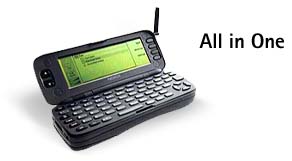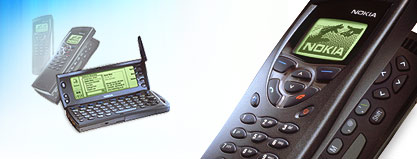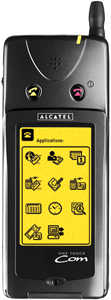|
|
Smartphone, mediaphone, communicator, what next?!
The last five years in the field of mobile communications has been marked by rapid changes in technology and decreasing cost to consumers. The mobile phone has transformed from impractical status symbol to indispensable appliance used daily as phone and notebook. Some functions may seem superfluous. Why check the time on a phone when clocks and watches are more accessible? Because of organizer functions, on the other hand, notebooks are becoming things of the past. It's convenient to store contact information on the phone and to dial from it directly. What about storing more complicated data, such as daily schedule, meetings, or notes? It's possible, but often foregone due to the arduous task of inputing from the keyboard. Try entering your daily schedule, pressing on small keys to input every item. Repetitive strain injury to your joints is virtually guaranteed. To circumvent this, one can input the data on a personal computer and synchronize the phone. But then you're stuck bringing your computer on trips, visits, and meetings, whenever you want to take notes.
Now imagine, that besides notes, you'd like to take along a book to read, travel information, email, i.e. pertinent info that's on your PC. This is a job for a PDA, not a phone, you say. But a smartphone can do it, too. This device unites the best features of mobile phone with handheld computer. Like any hybrid device, smartphones are a compromise solution, which must make certain concessions. In exchange they offer the convenience of one device use.

Like handheld computers, such devices can be divided into keyboard and non-keyboard. In industry jargon "smartphone" designates a non-keyboard device. A "communicator" carries a keyboard for inputting data. Frequently people confuse these two terms. Since they carry out similar functions, smartphones and communicators are distiguished only by the manner of input information and the size of device.
The beginning
The first attempts to expand the features of mobile phones were undertaken in the mid-90's. Several companies showed interest in developing such devices. In 1996, Nokia released Communicator Nokia 9000 and advanced it actively on the market. This device was first displayed during the March 1996 CEBIT exhibition in Germany and sales began that summer. Communicator was massive in size, a large hinged rectangular bar with a small display on the exterior. Inside, there was a big black-and-white screen (640x240 pixels) located in the top compartment and in the bottom a keyboard. The design, mode of opening, and unsurpassed functionality aroused great interest in this model. For the first time, sending and receiving of faxes, e-mail, www browser, data synchronization with PC, and more was possible from a mobile device. This combination of functions was accomplished by using the 386 processor from Intel. The operating system was GEOSTM 3.0. It was the first hybrid product that adapted existing technology to reduce time of development and expense. However, the use of standard components required an increase of size and weight compared to less advanced devices (173 x 64 x 38 mm, 397 grammes). The operating time was modest, up to 35 hours in standby mode and up to 3 hours in talk mode. Advertisements stated that without use of a phone, Communicator would run about one week. The reality was a three to four day maximum. An amazing 8 Mb of memory were installed in communicator: 4 Mb allocated for OS and 4 Mb for programs and user data. In 2000 8 Mb of memory were still the norm for similar devices, even in this Communicator was before its time.

Originally issued for GSM900 networks, by 1997 Communicator supported GSM1800 and GSM1900. At the 1998 CEBIT, Communicator 9110 was unveiled and available the following summer. The 9110 version was based on the 9000 communicator, with improved processor (486 processor replaced the 386), reduced weight (253 grammes) and size, and increased operating time. The model line has received development, but the device did not become something innovational. It was necessary to change the concept to do something new and the company made it. The model line was replaced in the summer of 2000 by Nokia 9210. This communicator used for the first time Symbian OS, a language developed specifically for mobile devices, and was served by a 32-bit ARM9 RISC processor. Since 9210, the communicators product line of communicators became such, as it has been initially planned. It was impossible to release a product of this kind (for its time, certainly), when there were no special widely spread processors and operating systems suitable for mobile devices in the market and in absence of community of software developers. Nokia managers perfectly realized it and that is why the company took part in creation of Symbian. We’ll talk about it later.

The success of Nokia 9000 stirred up so much interest from press and potential buyers that other companies entered the field. Competitors noted the weaknesses of Nokia 9000 and tried to offer other solutions. Reduction of weight by reducing screen size and omitting the keyboard, increased the operating time. Data input was assumed by touch screen, an innovation existing in handheld computers of that time. The new class of devices was termed smartphones.
The first models were made by Alcatel and Motorola. Smartphone Alcatel OneTouch Com accepted touch input of information and supported synchronization with Microsoft Outlook. The set of applications was scanty: contacts, records, day-book, and no way to install additional applications. In this, it differed from Communicator which supported the loading of new applications and the creation of applications by foreign developers. The Alcatel operating system was proprietary, developed internally within the company. These devices were not just a phone nor a mere handheld computer; smartphones were something else in between.

Motorola went on the same way with its Accompli series: its own OS, absence of application loading, but an expanded list of delivered appendices. The user was offered many applications, but not true freedom of choice. This basic contradiction between communicators and smartphones was already seen at the initial stage of development. Communicators were more expensive and functional; smartphones offered smaller quantity of functions with better convenience of use. Upon further development of technology these distinctions have eroded. Functionally, the devices are more and more similar. One key difference remains: the mode of inputting information.

To be continued>>>
Eldar Murtazin (eldar@mobile-review.com)
Translated by Andreas Von Horn (andreas@mobile-review.com)
Published — 07 May 2003
Have something to add?! Write us... eldar@mobile-review.com
|
News:
[ 31-07 16:21 ]Sir Jony Ive: Apple Isn't In It For The Money
[ 31-07 13:34 ]Video: Nokia Designer Interviews
[ 31-07 13:10 ]RIM To Layoff 3,000 More Employees
[ 30-07 20:59 ]Video: iPhone 5 Housing Shown Off
[ 30-07 19:12 ]Android Fortunes Decline In U.S.
[ 25-07 16:18 ]Why Apple Is Suing Samsung?
[ 25-07 15:53 ]A Few Choice Quotes About Apple ... By Samsung
[ 23-07 20:25 ]Russian iOS Hacker Calls It A Day
[ 23-07 17:40 ]Video: It's Still Not Out, But Galaxy Note 10.1 Gets An Ad
[ 19-07 19:10 ]Another Loss For Nokia: $1 Billion Down In Q2
[ 19-07 17:22 ]British Judge Orders Apple To Run Ads Saying Samsung Did Not Copy Them
[ 19-07 16:57 ]iPhone 5 To Feature Nano-SIM Cards
[ 18-07 14:20 ]What The iPad Could Have Looked Like ...
[ 18-07 13:25 ]App Store Hack Is Still Going Strong Despite Apple's Best Efforts
[ 13-07 12:34 ]Infographic: The (Hypothetical) Sale Of RIM
[ 13-07 11:10 ]Video: iPhone Hacker Makes In-App Purchases Free
[ 12-07 19:50 ]iPhone 5 Images Leak Again
[ 12-07 17:51 ]Android Takes 50%+ Of U.S. And Europe
[ 11-07 16:02 ]Apple Involved In 60% Of Patent Suits
[ 11-07 13:14 ]Video: Kindle Fire Gets A Jelly Bean
Subscribe
|




